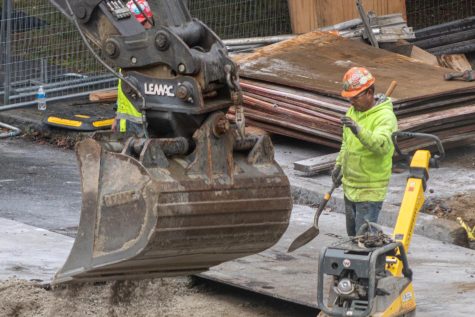Construction to Improve Heat and Reduce Waste
October 26, 2022

For those who live in the Flagg Townhouses, there’s no ignoring the large construction projects taking place in and around the first few blocks. But what’s it all about? Why is all this ruckus happening? What will be the end goal of all this construction? The Vice President of Administration and Finance, Mr. Joe DaSilva, has the answers.
The project began over the summer in July. “It’s actually a project that is being run and overseen by the Division of Capital Asset Management and Maintenance, which is a state agency that owns the majority of the buildings here on campus,” DaSilva said. This current construction project is financed by the Commonwealth of Massachusetts, as MCLA is a part of the state university system.
The civil engineering firm on the project is Vanasse Hangen Brustlin, Inc of Watertown, Massachusetts, with the general contractor being Bond Civil Engineering, and several other subcontractors all working together to complete the project. But what does the project entail, and how will that affect students?
“Well, there’s two goals. This is phase one of phase two,” DaSilva said. Part of the first phase is fixing water main piping that is outdated and unviable. That piping is being replaced in front of the power plant adjacent to the campus center, behind Bowman Hall on Montana Street and in front of Murdock Hall on Church Street. “They remove the old water pipes from the street, and they’re also bringing in water meters to all these buildings so we can accurately measure how much water each building is using,” DaSilva said. This mechanism will allow for problems in the system to be more easily identified. DaSilva estimates the water pipes to be between 50 and 70 years old, and in need of replacement.
“Part 2 will happen next summer,” DaSilva says of the time frame of the project. The steam heat of the townhouses is run through aging pipes, and steam meant for heating was being expelled away and wasted. “We’re losing 2900 gallons of water a day,” DaSilva said. The repairs being made to the water pipes will minimize that waste. These repairs have likely been long overdue, but this year its finally coming to fruition. The first phase of the project is expected to be completed on November 4th, which is a little less than a month away. Hopefully, the construction will cease, and students will have a less intrusive second half of their semesters.
As for how this project will affect students, DaSilva had this to say. After phase one ends, “They’re gonna hydroseed everything,” he said. Putting in new soil and grass, that is. This will make the campus nicer for students and create a more pleasing environment in contrast to the gouging trenches in front of different campus buildings. Although most of the changes taking place will be underground, DaSilva states that it will lower the utility costs of the college and provide some quality-of-life improvements. “If you live in the townhouses, you may notice you have better heat,” he said. Even though the repairs are taking place underground, many students may experience more comfortable heat in the winter.